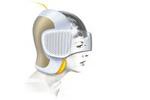Design Award for High-Tech Helmet
Direktzugriff
Artikelaktionen
Image: IMTEK
Medical technology doesn’t have to be unstylish: A helmet for magnetic resonance imaging (MRI) that researchers in Freiburg developed together with the Stuttgart design company “ipdd” has been selected for the “red dot award” in the category “design concept.” This is the first time a team from the University of Freiburg has received the prestigious design award, which is recognized internationally as a seal of quality.
The helmet was developed as part of a project on molecular imaging in medicine headed by Prof. Dr. Jan G. Korvink, Chair for Simulation at the Department of Microsystems Engineering (IMTEK). The project received funding from the Federal Ministry of Education and Research. In addition to researchers at IMTEK, the team also included experts on x-ray diagnostics at the Freiburg University Medical Center under Prof. Dr. Jürgen Hennig as well as partners from the industrial sector. The group studied the Hochfeld MRI procedure and new contrast media for diagnosing neurological diseases.
The idea of a helmet for imaging procedures is not new – but unlike conventional devices, the award-winning helmet is equipped with over 500 sensor nodes, enabling it to deliver images more quickly and in higher resolution. The researchers developed pentagonal and hexagonal magnet coils and arranged them as so-called phased arrays on a conductor plate. Much like the compound eye of an insect, the coils collect information simultaneously and independently of one another and process it. Thanks to their arrangement on the plate, which resembles the surface of a soccer ball, they can be placed close to the head of the patient.
Magnetic resonance imaging can take up to an hour and is often an uncomfortable affair. “We don’t want to make sick people sicker than they already are by subjecting them to an disagreeable and frightening technology. We took particular care to make the helmet comfortable and pleasing to the eye,” says Korvink. The helmet is padded on the inside and features an audiovisual system designed to draw the patient’s attention way from the imaging process: The patient can watch movies, listen to music, or contact a nurse at any time. The design of the display is modeled after the honeycomb arrangement of the sensor chip. The helmet is not white like most medical equipment but silver, gray, and yellow.
A jury of 17 internationally renowned design experts ranked 3,500 nominated products in the categories level of innovation, emotional and aesthetic appeal, functionality, practicability, and economic viability. The competition for design concepts and prototypes is an indicator of whether a product is fit for the market. It is held each year in Singapore. The official awards ceremony will be held there on 25 November 2011 at the “red dot design museum,” where the helmet will be on display for a year.
Fußzeile
Benutzerspezifische Werkzeuge

